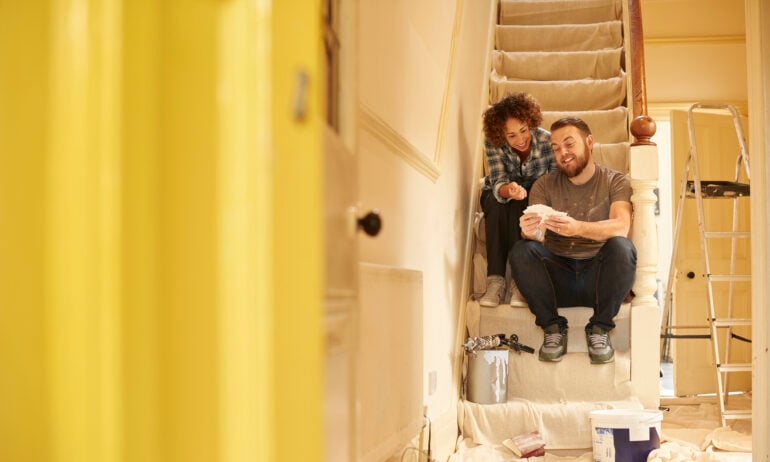Data: Home Improvement Spending Hits $827B

Many, or all, of the products featured on this page are from our advertising partners who compensate us when you take certain actions on our website or click to take an action on their website. However, this does not influence our evaluations. Our opinions are our own. Here is a list of our partners and here's how we make money.
Many homeowners are currently awash in equity, as home prices have climbed significantly over the past few years and fewer people have been moving. New data from the U.S. Census suggests some are getting more and more comfortable in their current digs — making improvements valued at hundreds-of-billions of dollars.
American homeowners spent about $827 billion on home improvement projects in the two year period ending in 2023, an increase of more than $200 billion over the previous two year period, according to the most recent American Housing Survey from the U.S. Census Bureau. This increase doesn’t only reflect pricier materials and labor, but also more projects — the number of projects grew by 4% during the period.
Pent up savings, healthy equity, high interest rates and a housing market that discouraged home buyers all made the timing good for upgrading existing homes and making them more comfortable.
“Many of us have a condition known as 'rate lock-in,’” explained NerdWallet mortgages expert Holden Lewis. “We would like to move to a place that's bigger or smaller or in a better location. But we're staying put — we're locked in — because we have a terrific mortgage rate that we don't want to give up. Instead of moving, we're fixing up our homes for our own comfort, enjoyment and energy efficiency — with the benefit of making our homes more valuable for when we finally list our homes for sale someday.”
Overview of recent home improvement projects
Every two years, the U.S. Census Bureau conducts the American Housing Survey. For their most recent release, they asked homeowners about their projects between 2021 and mid-2023. During that period, total dollar spending, average project costs and the number of projects in total all rose.
From the 2021 survey to the 2023 survey, total projects grew by 4% and total spending by 33%.
The most expensive projects were kitchen additions and renovations, which averaged close to $43,000. And projects overall cost about $6,200 each, on average, up from $4,800 in 2021.
Increasing project costs — both materials and labor — are no doubt to blame for part of the rising expenses to homeowners. But, homeowners were also more likely to hire professionals in 2023, as opposed to taking on the projects themselves, and professionally-done projects cost more, on average.
DIY vs. pro
The share of DIY projects fell in 2023, from 39% to 36%, a rate most recently seen in 2013. In the previous two-year period, as the world grappled with the early impacts of the coronavirus, people were far more likely to take on projects themselves, so the decrease in the 2023 survey period could mark a more typical home improvement environment.
It also represents a period of increased wealth — both home values and the stock market boomed — where many homeowners could afford to take on the costs of professional home improvement contracts. On average, DIY projects cost about $2,700 each, whereas professional projects ran $8,100.
Handy homeowner tip: Deciding whether to take a project on yourself comes down to more than just costs. YouTube and other online resources can help you learn new skills, but if you’re a complete beginner, tread cautiously. The expenses associated with fixing a DIY mistake can easily outweigh the costs of hiring a professional in the first place. Consider the risks and costs involved in both DIY and professional projects before moving forward with the choice that best fits your goals, budget and risk tolerance.
DIY by age
Younger homeowners are more likely to take on DIY home improvement projects — 62% of those under age 25 elected to get their hands dirty, and the DIY rate decreases with age. This is likely due to both costs and abilities: The youngest homeowners are more likely to have budget constraints and the physical ability to take on more difficult projects themselves.
Handy homeowner tip: No matter your age, if you’re opting to do home improvement projects yourself, follow the old adage of “measure twice, cut once,” meaning spend as much or more time on the preparation than the actual work. You want to get it right the first time, so don’t stop with a single YouTube video. Chat with someone who’s done work like yours before, consult a professional to see how they’d tackle it and enlist the help of a friend or two when it comes time to get your hands dirty. Home improvement projects can be incredibly rewarding when done right.
Funding those projects
As with years’ past, the majority of home improvement projects during the 2023 survey period were funded with cash from savings. These projects tend to cost less than those using most other sources of funding.
“Drawing from savings is the least expensive way to pay for renovations,” says Lewis. “But if your savings account isn't big enough, you can finance home improvements by tapping your home's equity.”Lewis explains there are three primary ways to tap your home's equity: “One is the cash-out refinance, which was popular when mortgage rates were below 5%. Nowadays, homeowners are turning to the home equity line of credit, which works like a credit card that is backed by your home, or to the home equity loan, in which you borrow a set amount in a lump sum.”
Handy homeowner tip: When deciding how to pay for your projects, consider both the total cost and how long you want to pay for it. While paying cash can cause a greater initial sting, you’ve paid off your project instantly and can move ahead to enjoying the products of your labor. However, higher dollar projects may require some additional time to pay. The right home improvement financing option is one where the monthly obligations and long-term costs fit your budget.

